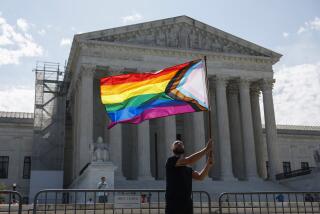Family of Tomorrow: It Won’t Be the Jetsons
- Share via
Remember George Jetson? His boy Elroy? Daughter Judy? Jane, his wife? That popular cartoon family lived an idyllic 1950s existence transplanted into a future of flying cars, talking dogs and assertive household appliances.
Forget the Jetsons. Instead, meet the real family of the future. Families, that is, because households of the 21st Century will be so diverse that no single family, not even a hypothetical one, can represent them all.
For example, tomorrow’s family is more likely to have one parent than two, at least at some point while the children are growing up, said Peter A. Morrison, director of the RAND Corp. Population Research Center, speaking this week at the Irvine Hilton. He was addressing the annual meeting of Florence Crittenton Services of Orange County, which provides services to troubled adolescent girls, many pregnant or with children, as well as abused and neglected infants and toddlers.
“It’s a situation where basically what we now refer to as the traditional family of American nostalgia with a male breadwinner, full-time female homemaker and children really isn’t there anymore,” said Morrison, a demographer and futurist who has testified before Congress on matters related to the family.
Each family of the next century may take several different forms over the years, he said. That same single-parent family may gain not just a step-parent but an extended step-family as well through marriage or remarriage, he said.
Another temporary configuration may be a 21st-Century version of the traditional extended family, in which “adults in their 50s and 60s who are caring for parents in their 80s and 90s find their children in their 20s and 30s knocking on the door, perhaps with their own children in tow” after a marital breakup, Morrison said.
Other typical families, he said, will consist simply of a husband and wife with no children and no plans for children.
Families that do have children will probably stick to somewhere near the rate of 1.8 children per family that has held steady for almost a decade, compared to the rate of 3.8 at the height of the baby boom.
Those families that do include two parents, whether they are both the child’s natural parents or a parent and stepparent, will most likely be two-income families. “Three-fourths of women will be in the workplace,” compared with just over 50% today, Morrison said.
And because there won’t be anyone home full time to tend to the family’s needs, “more and more of the things families used to do for members will be left undone,” he said.
Those things that absolutely must be done will increasingly be contracted out, he predicts, just as many families today already must do with child care and other responsibilities.
As the baby boomers of the post-World War II era become the senior citizens of the 21st Century, more and more families will need to provide care for their older members as well as their younger ones, Morrison said.
One shift that has already begun involves how families are formed. Although the most common way families begin is with marriage, an increasing number are started when single women give birth, he said.
In 1970, for example, single mothers accounted for 38% of births among blacks and 6% among whites. By 1986, that number had grown to 61% for blacks and 16% for whites. And recently, the rate has increased particularly among “mature, single white women in their 20s and 30s,” Morrison said.
“There are many women who have a stronger desire to have a child than to have a husband,” he said. He cited a recent survey which found that “50% of the women in that group said they would consider having a child without a partner if they were nearing the end of their childbearing years.”
Whether formed intentionally or as a result of marital breakups or unintended pregnancies, Morrison said single-parent families, and the children who live in them, will be more vulnerable because they will be dependent on only one working adult. “That implicitly exposes the family to a potential to lapse into poverty in the event of unemployment or anything going wrong,” he said.
And because a single adult’s income usually can’t match that of a dual-income family, single-parent families will also have more difficulty paying for services that once were provided by housewives, Morrison said.
Families formed with two adults may not stay that way, Morrison said. “Marriages are not likely to last a lifetime. People are divorcing more readily and they’re divorcing earlier.”
In 1985, 21% of women ages 25 to 29 had been divorced, and it was projected that 33% more would follow suit at some point in their lives. Among women 35 to 39, 32% had already divorced and 24% were expected to do so. But of women 45 to 49, only 29% had divorced and 7% were expected to divorce.
There is also a “steady decline in the average age of divorcing couples,” Morrison said. Among women who are now 55 years old, 25% had been divorced by age 43. But women who are now 35 reached that same 25% level at age 29, he said.
Those divorces are “usually followed by a second marriage and a resumption of married life,” Morrison said.
“Most of today’s children will spend some part of their youth in single-parent families,” he said. Among children born from 1950 to 1954, 48% of blacks and 19% of whites spent some part of their childhoods with only one parent. For children born in 1980, those numbers have jumped to 94% of blacks and 70% of whites.
What it all comes down to, Morrison said, is that families will be more complex as well as more diverse. “There will be a lot more intrinsic complexity in the obligations that go with the relationships in families.”
He predicts that families in general will be more dependent on the public sector for help with both child care and care for the elderly.
More to Read
Sign up for Essential California
The most important California stories and recommendations in your inbox every morning.
You may occasionally receive promotional content from the Los Angeles Times.













